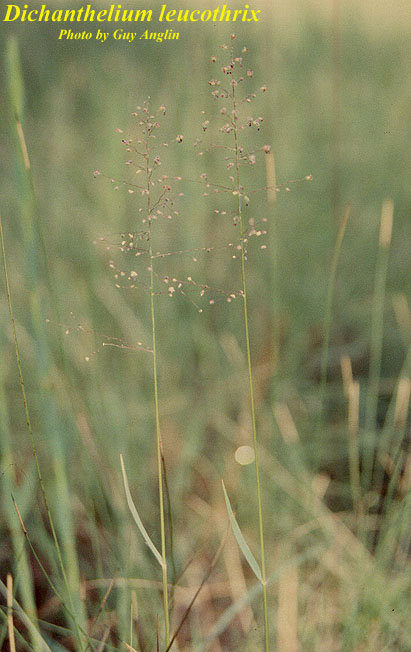Difference between revisions of "Dichanthelium leucothrix"
Rwagner914 (talk | contribs) |
|||
| Line 8: | Line 8: | ||
| divisio = Magnoliophyta - Flowering plants | | divisio = Magnoliophyta - Flowering plants | ||
| classis = Liliopsida – Monocotyledons | | classis = Liliopsida – Monocotyledons | ||
| − | | ordo = | + | | ordo = Poales |
| familia = Poaceae ⁄ Gramineae | | familia = Poaceae ⁄ Gramineae | ||
| genus = ''Dichanthelium'' | | genus = ''Dichanthelium'' | ||
Revision as of 14:45, 29 June 2017
| Dichanthelium leucothrix | |
|---|---|

| |
| Photo by Guy Anglin, Atlas of Florida Vascular Plants | |
| Scientific classification | |
| Kingdom: | Plantae |
| Division: | Magnoliophyta - Flowering plants |
| Class: | Liliopsida – Monocotyledons |
| Order: | Poales |
| Family: | Poaceae ⁄ Gramineae |
| Genus: | Dichanthelium |
| Species: | D. leucothrix |
| Binomial name | |
| Dichanthelium leucothrix (Nash) Freckmann | |

| |
| Natural range of Dichanthelium leucothrix from USDA NRCS Plants Database. | |
Common names: Rough panicgrass; Rough witchgrass
Contents
Taxonomic notes
Synonyms: Panicum leucothrix Nash; D. acuminatum ssp. leucothrix (Nash); P. spretum J.A. Schultes; P. acuminatum Swartz var. leucothrix (Nash) Lelong; D. acuminatum (Swartz) Gould & Clark var. implicatum (Scribner) Gould & Clark; P. spretum var. leucothrix (Nash) D.B. Ward
Description
Generally, for the Dichanthelium genus, they have "spikelets usually in panicles, round or nearly so in cross section, 2-flowered, terminal fertile, basal sterile, neutral or staminate. First glume usually present, 2nd glume and sterile lemma similar; fertile lemma and palea indurate without hyaline margins. Taxonomically our most difficult and least understood genus of grasses, more than 100 species an varieties are ascribed to the Carolinas by some authors. Note general descriptions for species groups (e.g., 1-4, 5-8, 9-13, and 26-62)." [1]
Specifically, for the D. leucothrix species, they are "perennial with distinct basal rosettes; branching, when present, from nodes above basal rosette. Leaves basal and cauline, vernal and autumnal. Culms 3-6.5 dm tall, nodes slightly bearded, internodes glabrous or pilose. Blades to 6 cm long, 2-5 cm wide, glabrous above, setose basally, puberulent beneath, margins scaberulous, basally ciliate; sheaths sparsely pilose or glabrous, margins occasionally ciliate; ligules ciliate, 2-3 mm long. Panicle 3-6 cm long, 2.5-4 cm broad; rachis appressed pilose or glabrous, branches spreading, smoothish. Spikelets ellipsoid, 1.2-1.4 mm long; pedicels smoothish. First glume glabrous or pubescent, truncate or acute, 0.2-0.5 mm long, 2nd glume and sterile lemma pubescent, obtuse, 1.2-1.4 mm long; fertile lemma and palea 1.1-1.5 mm long. Grain not seen." [1]
Distribution
Ecology
Habitat
Dichanthelium leucothrix can occur in longleaf pine-wiregrass flatwoods, and cypress-gum depressions in flatwoods. [2]
Conservation and management
Cultivation and restoration
Photo Gallery
References and notes
- ↑ 1.0 1.1 Radford, Albert E., Harry E. Ahles, and C. Ritchie Bell. Manual of the Vascular Flora of the Carolinas. 1964, 1968. The University of North Carolina Press. 142-155. Print.
- ↑ Florida State University Robert K. Godfrey Herbarium database. URL: http://herbarium.bio.fsu.edu. Last accessed: October 2015. Collectors: H.L. Blomquist and Robert K. Godfrey. States and Counties: Florida: Liberty. North Carolina: Carteret.